Denver’s office buildings are greener then ever before, but some metro areas are speeding by the Mile High City when it comes to adopting sustainability standards for commercial space, according to a new report.
The 2018 U.S. Green Building Adoption Index found that 45.2 percent of all office space in Denver is certified sustainable under either LEED or EPA Energy Star standards or both. That represents more than 51.3 million square feet of space in 209 buildings, according to CBRE, the commercial real estate firm that compiled the index along with Maastricht University.
In 2017, 41.9 percent of Denver’s office space held sustainability certifications. Despite its continued growth, when compared to the 29 other American metro areas surveyed for the study, Denver’s rate of greening has slowed.
Denver was ranked seventh among the country’s 30 largest metro areas for green standard adoption in 2017. This year, it fell to ninth after being vaulted by Manhattan and Washington, D.C. The office markets in those cities are 46.1 percent and 45.9 percent green certified, respectively.
“Perhaps some of the reason we are falling off the pace is there are cities and jurisdictions that have become very progressive and aggressive with codes and mandates” regarding sustainability, said Sara Gutterman, CEO of Green Builder Media, a Lake City-based media company focused on green building and sustainable living. “It’s really being driven by the code process.”
The mayors of Washington, D.C., and New York City signed a pledge this week committing to making all new buildings in their city net zero carbon emitters by 2030. LEED certification for new construction makes up just 3.7 percent of all certified space today, CBRE found.
Denver has put higher demands on new construction in recent years. Since 2016, all new buildings have been held to international energy conservation standards, Jill Jennings Golich, the city’s deputy director of community planning and development, said. The city has also had a “benchmarking” ordinance requiring buildings over 25,000 square feet to report their annual energy use.
“We are currently in the planning stages of our next building code update, which will include new ways to promote greener construction in our city,” Golich said via email.

The most demanding regulation for green building in Denver is still being worked on at city hall. The voter-approved Green Roof Initiative is being tweaked by a task force now to allow builders some flexibility in how they meet demands for sustainability and built-in vegetation in their projects.
Related Articles
-
Judge freezes assets of Denver’s former Writer Square owner
-
Cryptocurrency could be the future of real estate along the Front Range
-
Trade workers shortage hurting Fort Collins housing market
-
Vail Resorts closes on Stevens Pass acquisition
-
Centennial’s Innovation Pavilion silent in new CEO announcement about recent sexual assault allegations against founder
Brandon Rietheimer, who led the green roof campaign, said addressing office building efficiency is critical to the environment because it is estimated large buildings account for 60 percent of greenhouse gas emissions. In the long run, green buildings are more economical because of their lower energy bills and desirability to increasingly eco-minded tenants.
“I think it’s something that’s on everybody minds these days,” Rietheimer said. “If your building is greener, you feel better working in it. It’s becoming more of a standard now.”
CBRE researchers found that buildings with Energy Star or LEED certifications are valued and sold for roughly 10.1 percent more than un-certified buildings.

